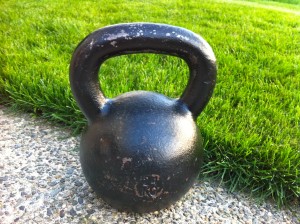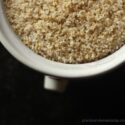I love kettlebells. I love their versatility, utility, and even their value. I love that they take up a tiny corner of my home office and have proven more useful for my fitness than all of the free weights in my garage. I read about them, work with them and play with them, and they have helped make me stronger in my 37th year than I have been in any year prior. But with all that said, I always want to temper the advice I give in these posts with the appropriate disclaimers.

I prefer this 53# bell for my Clean and Presses.
Namely, I’m not an expert on kettlebells. I don’t profess to be one, and I never have. I’m not certified, though I’d like to pursue that at some point. I train according to “hard style,” Russian Kettlebell Challenge (RKC) standards and philosophy, based on personal research. I test myself like the RKC would, I hope, and try to refine my technique to maximize effectiveness, benefit and safety for my effort.
All that being said, when folks have a good thing, they like to share the goodness with others. So questions about where to begin with kettlebells often come my way. And my answer is always the same:
Start with the Swing.
Let me give you three reasons why.
The Swing is the foundational movement among kettlebell lifts.
The Swing is what’s called a “hip-hinge,” and the power for the swing does come from the hips. The hips are pretty important and are often neglected in much of our strength training today. But when you develop this explosiveness from the hips, you’ve effectively established the foundation for a solid Snatch and Clean.
The Clean is basically a one-handed swing with your elbows anchored to your ribs; the bell rests into place in the “Rack” position.
And the Clean is essential for the Clean and Press, the Front Squat, or anything else you do with the bell in the Rack position. You have to crawl before you can walk, and you have to Swing before you can Clean.
The Swing promotes explosiveness and athleticism…without requiring a single step.
I have knee issues. I have for years. I’m able to function without pain generally, but any hard planting with my left leg is usually greeted with some nagging aching for a few days. I’d argue that it’s just my aging joints speaking, but it’s bugged me since open gym basketball in college, so it’s not just my age.
But rather than use that as an excuse to never get my heart rate up, I do ballistic lifts with my kettlebells. It happens that I’ve worked harder to perform high-rep Swings and Snatches while my heart feels like it’s going to pop out of my chest than I ever have running or playing basketball, tennis, or soccer. (Again, that’s me personally; there are tremendous athletes in those sports, but my knee – and time – prevent me from practicing or playing those with any regularity.) And doing Swings and Snatches don’t require me to – as I said – take a single step. You do them with your feet anchored in place. I therefore find them to be easy on the joints, like many body weight exercises. This is important if my training regimen is to be sustainable.
The Swing works most of the jumping muscles…without jumping. And it does so more explosively than the Deadlift or the Squat.
The Swing is a great exercise in its own right.
I’ve sung the praises of the Deadlift before, and I do believe it may well be the greatest exercise in the world, particularly for developing maximum strength. I won’t ramble about that here (if you want more on that, go HERE). But given that the kettlebell Swing is basically a ballistic cousin to the Deadlift, anyone who can appreciate the Deadlift should be able to appreciate the Swing. Fair enough?
Do 200 Swings in less than 10 minutes, and you’ll be feeling it in your forearms (grip), glutes, hamstrings, and lower back. If you do it right, you may be feeling it in your core, too. Approach fatigue, and you’ll probably feel it in your traps the next day, since you’ll start to recruit those muscles to pull the bell up (never the goal; you shouldn’t do that. I’m just saying there are a lot of muscle groups involved).
Doing Swings helps the entire posterior chain, and many gym rats today who are focused on a big Bench Press or a big Squat neglect their backs…to their own peril. They’d do well to invite some Deadlifts or some Swings or Pull-ups to the party.
So there’s a start. Stay tuned for a simple, swing-based program I recently wrote out for a friend who wanted to get started with kettlebells.
Oh, and here are a few swing-based workouts, for your perusal:







Leave a Reply